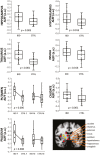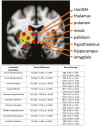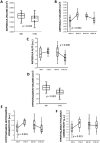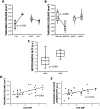Multimodal Brain MRI of Deep Gray Matter Changes Associated With Inflammatory Bowel Disease
- PMID: 35590449
- PMCID: PMC9977255
- DOI: 10.1093/ibd/izac089
Multimodal Brain MRI of Deep Gray Matter Changes Associated With Inflammatory Bowel Disease
Abstract
Background: Behavioral symptoms, including mood disorders, substantially impact the quality of life of patients with inflammatory bowel disease (IBD), even when clinical remission is achieved. Here, we used multimodal magnetic resonance imaging (MRI) to determine if IBD is associated with changes in the structure and function of deep gray matter brain regions that regulate and integrate emotional, cognitive, and stress responses.
Methods: Thirty-five patients with ulcerative colitis (UC) or Crohn's disease (CD) and 32 healthy controls underwent 3 Tesla MRIs to assess volume, neural activity, functional connection strength (connectivity), inflammation, and neurodegeneration of key deep gray matter brain regions (thalamus, caudate, pallidum, putamen, amygdala, hippocampus, and hypothalamus) involved in emotional, cognitive and stress processing. Associations with sex, presence of pain, disease activity, and C-reactive protein (CRP) concentration were examined.
Results: Significantly increased activity and functional connectivity were observed in cognitive and emotional processing brain regions, including parts of the limbic system, basal ganglia, and hypothalamus of IBD patients compared with healthy controls. Inflammatory bowel disease patients exhibited significantly increased volumes of the amygdala and hypothalamus, as well as evidence of neurodegeneration in the putamen and pallidum. Hippocampal neural activity was increased in IBD patients with active disease. The volume of the thalamus was positively correlated with CRP concentration and was increased in females experiencing pain.
Conclusions: Patients with IBD exhibit functional and structural changes in the limbic and striatal systems. These changes may be targets for assessing or predicting the response to therapeutic interventions aimed at improving comorbid emotional and cognitive symptoms.
Keywords: IBD; MRI; amygdala; basal ganglia; brain.
Plain language summary
Magnetic resonance imaging revealed structural and functional changes within the brains of inflammatory bowel disease patients, in regions known to be involved in processing brain signals associated with behavioral symptoms, anxiety, pain, stress, and cognitive deficits.
© The Author(s) 2022. Published by Oxford University Press on behalf of Crohn’s & Colitis Foundation. All rights reserved. For permissions, please e-mail: journals.permissions@oup.com.
Figures





References
-
- Baumgart DC, Sandborn WJ.. Inflammatory bowel disease: clinical aspects and established and evolving therapies. Lancet. 2007;369(9573):1641–1657. - PubMed
-
- Mikocka-Walus A, Knowles SR, Keefer L, Graff L.. Controversies revisited: a systematic review of the comorbidity of depression and anxiety with inflammatory bowel diseases. Inflamm Bowel Dis. 2016;22(3):752–762. - PubMed
-
- Mikocka-Walus A, Pittet V, Rossel JB, von Kanel R; Swiss IBDCSG. Symptoms of depression and anxiety are independently associated with clinical recurrence of inflammatory bowel disease. Clin Gastroenterol Hepatol. 2016;14(6):829–835 e821. - PubMed
-
- Lix LM, Graff LA, Walker JR, et al. . Longitudinal study of quality of life and psychological functioning for active, fluctuating, and inactive disease patterns in inflammatory bowel disease. Inflamm Bowel Dis. 2008;14(11):1575–1584. - PubMed
-
- Dolovich C, Bernstein CN, Singh H, et al. . Anxiety and depression leads to anti-tumor necrosis factor discontinuation in inflammatory bowel disease. Clin Gastroenterol Hepatol. 2021;19(6):1200–1208. - PubMed
Publication types
MeSH terms
Grants and funding
LinkOut - more resources
Full Text Sources
Medical
Research Materials
Miscellaneous

